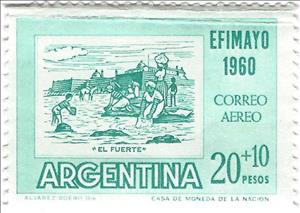Stamp: The Fort ("El Fuerte") (Argentina 1960)
The Fort ("El Fuerte") (Argentina 1960)
20 August (Argentina ) within release Inter-American Philatelic Exhibition EFIMAYO 196 goes into circulation Stamp The Fort ("El Fuerte") face value 20+10 Argentine peso moneda nacional
| Stamp The Fort ("El Fuerte") in catalogues | |
|---|---|
| Michel: | Mi:AR 740 |
| Stamp Number: | Sn:AR CB22 |
| Götig and Jalil: | Göt:AR 1186 |
| Gz (Cefiloza): | Gz:AR Ae99 |
Stamp is horizontal format.
Also in the issue Inter-American Philatelic Exhibition EFIMAYO 196:
- Stamp - Oxcart water carrier ("El Aguatero") face value 6+3;
- Stamp - Discharge of a sailing boat /El desembarcadero) face value 10.70+5.30;
- Stamp - The Fort ("El Fuerte") face value 20+10;
Stamp The Fort ("El Fuerte") it reflects the thematic directions:
Coastal areas are local administrative units (LAUs) that are bordering or close to a coastline. A coastline is defined as the line where land and water surfaces meet (border each other).
A fortification (also called a fort, fortress, fastness, or stronghold) is a military construction designed for the defense of territories in warfare, and is used to establish rule in a region during peacetime. The term is derived from Latin fortis ("strong") and facere ("to make").
A people is a plurality of persons considered as a whole, as is the case with an ethnic group or nation. Collectively, for example, the contemporary Frisians and Danes are two related Germanic peoples, while various Middle Eastern ethnic groups are often linguistically categorized as Semitic peoples.
A river is a natural freshwater stream that flows on land or inside caves towards another body of water at a lower elevation, such as an ocean, lake, or another river. A river may run dry before reaching the end of its course if it runs out of water, or only flow during certain seasons. Rivers are regulated by the water cycle, the processes by which water moves around the Earth. Water first enters rivers through precipitation, whether from rainfall, the runoff of water down a slope, the melting of glaciers or snow, or seepage from aquifers beneath the surface of the Earth.



